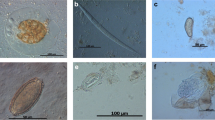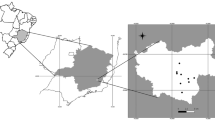Abstract
The gopher tortoise (Gopherus polyphemus), one of five tortoise species endemic in the USA, was recently classified as a candidate for federal listing as a threatened species. Fecal samples collected from 117 tortoises from eight sites in Georgia were examined for endoparasites using a combination of sedimentation and flotation. Samples from an island population were examined for parasitic oocysts and ova only by flotation, protozoan cysts by trichrome-stained direct smear, and Cryptosporidium by direct immunofluorescence assay and ProSpecT rapid assay. A total of 99 tortoises (85, range 0–100 %) was infected with pinworms (Alaeuris spp.), 47 (40, 0–86 %) with cestodes (Oochorstica sp.), 34 (41, 0–74 %) with Chapiniella spp., 2 (3, 0–33 %) with Eimeria paynei, and a single tortoise each with a capillarid and ascarid (1 %). On the island, Entamoeba was detected in one tortoise (2 %) while Cryptosporidium oocysts were detected in eight (17 %). In conclusion, at least eight species of parasites were detected including Cryptosporidium, a possible pathogen of tortoises. Interestingly, we detected spatial variation in the distribution of several parasites among populations suggesting additional work should be conducted across a gradient of tortoise densities, land use, and habitat characteristics.

Similar content being viewed by others
References
Arizmendi-Espinosa MA, García-Prieto L, Guillén-Hernández S (2005) A new species of Oochoristica (Eucestoda: Cyclophyllidea) parasite of Ctenosaura pectinata (Reptilia: Iguanidae) from Oaxaca. Mexico J Parasitol 91:99–101
Auffenberg W, Franz R (1982) The status and distribution of the gopher tortoise (Gopherus polyphemus). In: Bury RB (ed) North American tortoises: conservation and ecology. Wildlife Research Report No. 12, Washington, pp 95–126
Ballou A (2013) Aspects of gopher tortoise (Gopherus polyphemus) populations in Georgia: status, landscape predictors, and juvenile movements and burrow use. MSc. Thesis. University of Georgia, Athens, 96 pp
Bouamer S, Morand S, Bourgat R (2001) Oxyuroids of Palearctic Testudinidae: new definition for Alaeuris Seurat, 1918 (Nematoda: Pharyngodonidae) and redescription of Alaeuris numidica. J Parasitol 87:128–133
Brownstein DG, Strandberg JD, Montali RJ, Bush M, Fortner J (1977) Cryptosporidium in snakes with hypertrophic gastritis. Vet Pathol 14:606–617
Bursey CR, Goldberg SR (1992) Oochoristica islandensis n. sp. (Cestoda: Linstowiidae) from the desert night lizard Xantusia vigilis vigilis (Xantusiidae). Trans Am Microsc Soc 111:36–43
Bursey CR, Goldberg SR, Woolery DN (1996) Oochoristica piankai sp. n. (Cestoda: Linstowiidae) and other helminths of Moloch horridus (Sauria: Agamidae) from Australia. J Helminthol Soc of Wash 63:215–221
Diaz-Figueroa O (2005) Characterizing the health status of the Louisiana gopher tortoise (Gopherus polyphemus). Thesis. Louisiana State University, Baton Rouge, p 109 pp
Eisenberg JF (1983) The common tortoise as a keystone species. Florida State Museum, Gainesville, 4pp
Ernst JV, Fincher GT, Stewart TB (1971) Eimeria paynei sp. n. (Protozoa: Eimeriidae) from the gopher tortoise (Gopherus polyphemus). Proc Helminthol Soc Wash 38:223–224
Graczyk TK, Cranfield MR, Mann J, Strandberg JD (1998) Intestinal Cryptosporidium sp. infection in the Egyptian tortoise, Testudo kleinmanni. Int J Parasitol 28:1885–1888
Griffin C, Reavill DR, Stacy BA, Childress AL, Wellehan JF Jr (2010) Cryptosporidiosis caused by two distinct species in Russian tortoises and a pancake tortoise. Vet Parasitol 170:14–19
Hermann SM, Guyer C, Waddle JH, Nelms MG (2002) Sampling on private property to evaluate population status and effects of land use practices on the gopher tortoise, Gopherus polyphemus. Biol Conserv 108:289–298
Heuschele WP, Oosterhuis J, Janssen D, Robinson PT, Ensley PK, Meier JO, Olson T, Anderson MP, Benirschke K (1986) Cryptosporidial infections in captive wild animals. J Wildl Dis 22:493–496
Jackson DR, Milstrey EG (1989) The fauna of gopher tortoise burrows. In: Diemer JE, Jackson DR, Landers JL, Layne JN, Wood DA (eds) Gopher Tortoise Relocation Symposium Proceedings. Florida Game and Fresh Water Fish Commission, Nongame Wildlife Program Technical Report 5, pp 86–98
Jacobson ER (2007) Parasites and parasitic diseases of reptiles in Infectious Diseases and Pathology of Reptiles. CRC, Boca Raton, pp 571–665, 716 pp
Lichtenfels JR, Stewart TB (1981) Three new species of Chapiniella Yamaguti, 1961 (Nematoda: Strongyloidea) from tortoises. Proc Helminthol Soc Wash 48:137–147
McCoy ED, Mushinsky HR, Lindzey J (2005) Declines of the gopher tortoise on protected lands. Biol Conserv 128:120–127
McRae WA, Landers JL, Cleveland GD (1981) Sexual dimorphism in the gopher tortoise (Gopherus polyphemus). Herpetologica 37:46–52
Petter AJ, Douglass JF (1976) Etude des populations d'Oxyures du colon des Gopherus (Testudinidae). Bull Mus Natl Hist Natur, strie 3, no. 389. Zoologie 271:731–768
Raphael BL, Calle PP, Gottdenker N, James S, Linn WJ, McNamara T, Cook RA (1997) Clinical significance of Cryptosporidia in captive and free-ranging chelonians. In Proceedings of the Annual meeting of the American Association of Zoo Veterinarians, Houston, Texas. AAZV 1997:19–20
Stedman NL, Garcia A, and Latimer KS (2000) Severe hepatic necrosis associated with entamoebiasis in a gopher tortoise (Gopherus polyphemus). Proceedings of International Virtual Conferences in Veterinary Medicine: Diseases of Reptiles and Amphibians. http://www.vet.uga.edu/vpp/archives/ivcvm/2000/stedman/index.php
Steelman GM (1939) Oochoristica whitentoni, a new anoplocephalid cestode from a land tortoise. J Parasitol 25:479–482
Tuberville TD, Norton TM, Todd BD and Spratt JS (2008) Long-term apparent survival of translocated gopher tortoises: a comparison of newly released and previously established animals. Biol Conserv 141:2690–2697
U.S. Fish and Wildlife Service (2011).Endangered and Threatened Wildlife and Plants; 12-Month Finding on a Petition To List the Gopher Tortoise as Threatened in the Eastern Portion of Its Range; Final Rule. http://www.fws.gov/northflorida/GopherTortoise/12-month_Finding/20110726_frn_Gopher-Tortoise_12month_finding.htm. Accessed 5 Sept 2012
Walton AC (1927) A revision of the nematodes of the Leidy Collection. Proc Acad Nat Sci Phil 79:49–163
Wendland LD (2007) Epidemiology of mycoplasmal upper respiratory tract disease in tortoises. Ph.D. Dissertation. University of Florida, Gainesville, 171 pp
Witz BW, Wilson DS, Palmer MD (1991) Distribution of Gopherus polyphemus and its vertebrate symbionts in three burrow categories. Am Midl Nat 126:152–158
Acknowledgments
We would like to thank Lora L. Smith for the helpful comments on the earlier versions of the manuscript. JLM was supported by the Warnell School of Forestry and Natural Resources at UGA and the J. W. Jones Ecological Research Center. Additional funding was provided by the Southeastern Cooperative Wildlife Disease Study through sponsorship with member states, The Gopher Tortoise Council, Sigma Xi, and the Sophie Danforth Conservation Biology Fund.
Author information
Authors and Affiliations
Corresponding author
Rights and permissions
About this article
Cite this article
McGuire, J.L., Miller, E.A., Norton, T.M. et al. Intestinal parasites of the gopher tortoise (Gopherus polyphemus) from eight populations in Georgia. Parasitol Res 112, 4205–4210 (2013). https://doi.org/10.1007/s00436-013-3612-z
Received:
Accepted:
Published:
Issue Date:
DOI: https://doi.org/10.1007/s00436-013-3612-z




